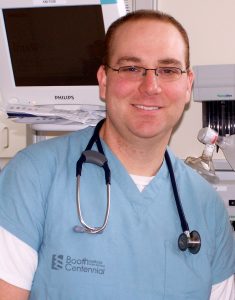KDH’s new ER Chief, Dr. Jonathan Rathwell, explains what goes on behind the scenes in a busy Emergency Room
Hospital emergency rooms (ERs) are often in the headlines – due to wait times, record numbers of patients during flu season, aggression toward ER staff, and more.
What is missing from most of these news stories is a discussion of how ERs function from day to day. People who come to Emergency are very conscious of their own condition, but often quite unaware of what might be going on beyond the waiting room. As a result, there can be a mismatch in expectations on both sides of the gurney.
With the help of Kemptville District Hospital (KDH)’s new Chief of Emergency Services, Dr. Jonathan Rathwell, this article will attempt to bring those mismatched expectations more closely into alignment.
Emergency Room 101
Emergency Rooms are fast-paced, often stressful environments where complex multi-tasking and teamwork are essential. The doctors and nurses who choose to work in emergency medicine possess these abilities and more.
On any given shift, ER staff may see patients with conditions ranging from a sprained ankle to traumatic, life-threatening injuries. Some patients are critically ill; others could be managed by their family doctor. Lacerations, abdominal pain, fevers, broken bones, stroke, cardiac arrest, suicidal thoughts – patients with these conditions keep Emergency Rooms throughout the province busy. Stabbings, gunshot wounds, and drug overdoses are more common in the city, but are not absent from community hospitals.
ER patients range in age from babies to the elderly, and come from a variety of socio-economic and cultural backgrounds. Most ER patients are under stress as a result of pain and/or worry about their medical conditions; some are intoxicated; some have serious psychiatric problems; some are homeless. Some are violent; some threaten and sometimes even assault members of the healthcare team.
Hospital Emergency Rooms see everyone who comes through the door, regardless of past history. No one is turned away. At KDH, every patient receives the same high quality and safe care.
Despite the stress and element of danger, doctors and nurses who dedicate their lives to emergency medicine speak about how fulfilling it is.
Dr. Jonathan Rathwell is KDH’s new Chief of Emergency Services. He is also well known and respected in the North Grenville community as a family doctor, having practiced family medicine in Kemptville since 2007.
Dr. Rathwell reflected recently on why he chose emergency medicine. “For patients experiencing medical emergencies, the quick and skilled actions of the healthcare professionals caring for them often mean the difference between life and death,” he said. “Knowing that you have saved someone’s life is infinitely rewarding.”
Q&A with Dr. Jonathan Rathwell
We asked Dr. Rathwell to answer some of the most frequently asked questions about the ER.
Q: I was in the ER recently and there were only two other people in the waiting room, and yet I had to wait three hours to be seen by the doctor. Why?
A: When you are in the ER waiting area, you have no way of knowing what is happening within the ER itself. In this case, most likely there were people with life-threatening conditions being treated in the ER. Perhaps an ambulance came in with one or more casualties of a car accident. In a small emergency room like ours with one physician and limited nursing staff on duty, one very ill patient can occupy all of our resources for a long period of time. As a result, people with non-life-threatening conditions will have a longer wait. We know waiting is tough – and waiting without knowing why is tougher. As much as we can, we will keep you informed about the reason for any delays.
Q: Why don’t you post ER wait times? I want to have that information when deciding which hospital’s ER I will visit.
We made the decision not to post wait times because, without an automated process for determining them, we would just be posting an educated guess, and this would often be inaccurate. It’s difficult in general to predict ER wait times, but it is particularly so in a small emergency room like ours where, as I mentioned, one very ill patient can exhaust all resources. Wait times fluctuate rapidly, as there may be only a 30-minute wait at one point, and then a large trauma comes in that requires the attention of all staff for an extended period, and the wait shoots to several hours. That being said, you could reasonably expect to usually have a shorter wait time in Kemptville than you would in a big city hospital where they see a much greater volume of patients.
Q: On my last visit to your ER I took a number, was triaged, and then sat down to wait my turn. Several people came in after me and I saw them talking to staff at the Patient Registration desk and then they went through the doors ahead of me.
A: Because KDH is a small hospital, intake for our ER, for outpatient clinics, and for Diagnostic Imaging (x-ray, ultrasound, etc) happens in the same place. So the people you saw going through the doors leading out of the ER would have had pre-arranged appointments for either a diagnostic test or one of our clinics. People with pre-arranged appointments do not need to take a number – that is for Emergency patients only – and are asked to wait behind the red line at our Patient Welcome Centre. I would note we ask people to wait behind the red line so that people talking to Patient Registration staff will not have their personal health information overheard.
Q: I went to Emergency with a knee injury. I thought I should have an x-ray to determine the extent of my injury. The doctor told me it was a soft tissue injury, and gave me instructions for taking ibuprofen and icing my knee, but did not order an x-ray. Should I have insisted on having one?
A: Emergency Room doctors follow evidence-based guidelines with respect to knee x-rays and a host of other conditions. Since you had a soft tissue injury, and since x-rays show bone only, an x-ray would not have been helpful. Sometimes patients feel they need certain tests that aren’t clinically indicated or warranted. Part of our role as physicians is to be judicious about healthcare spending, and not to order tests or write prescriptions unnecessarily. In your case, your injury would best have been managed by your family doctor, who could follow up with you as necessary.
About Kemptville District Hospital
Kemptville District Hospital is Accredited with Exemplary Standing, the highest ranking bestowed by Accreditation Canada. Committed to building healthier communities, we are a model of hospital-led integrated health services within the provincial health system. Kemptville District Hospital consistently ranks among the top hospitals in Ontario for both patient and employee satisfaction. We pride ourselves on being a good partner within the system. Kemptville District Hospital provides primary care management services, acute care hospital services, and advanced orthopaedic care.
For further information contact:
Jenny Read, Communications Officer
T: 613-258-6133 extension 223
Email: jread@kdh.on.ca

Open ProfileStaff ProfileSteveMaintenance Mechanic, Stationary Engineering Team Lead
Read Profile19,127
patients seen in the KDH ER last year


